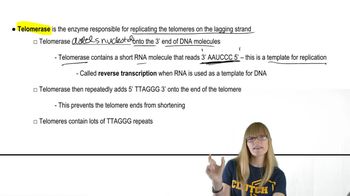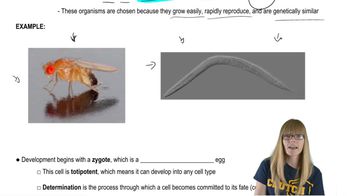Telomeres are found at the ends of eukaryotic chromosomes. Why is telomerase usually active in germ-line cells but not in somatic cells?
Table of contents
- 1. Introduction to Genetics51m
- 2. Mendel's Laws of Inheritance3h 37m
- 3. Extensions to Mendelian Inheritance2h 41m
- 4. Genetic Mapping and Linkage2h 28m
- 5. Genetics of Bacteria and Viruses1h 21m
- 6. Chromosomal Variation1h 48m
- 7. DNA and Chromosome Structure56m
- 8. DNA Replication1h 10m
- 9. Mitosis and Meiosis1h 34m
- 10. Transcription1h 0m
- 11. Translation58m
- 12. Gene Regulation in Prokaryotes1h 19m
- 13. Gene Regulation in Eukaryotes44m
- 14. Genetic Control of Development44m
- 15. Genomes and Genomics1h 50m
- 16. Transposable Elements47m
- 17. Mutation, Repair, and Recombination1h 6m
- 18. Molecular Genetic Tools19m
- 19. Cancer Genetics29m
- 20. Quantitative Genetics1h 26m
- 21. Population Genetics50m
- 22. Evolutionary Genetics29m
8. DNA Replication
Telomeres and Telomerase
Problem 26
Textbook Question
At the end of the short arm of human chromosome 16 (16p), several genes associated with disease are present, including thalassemia and polycystic kidney disease. When that region of chromosome 16 was sequenced, gene-coding regions were found to be very close to the telomere-associated sequences. Could there be a possible link between the location of these genes and the presence of the telomere-associated sequences? What further information concerning the disease genes would be useful in your analysis?
 Verified step by step guidance
Verified step by step guidance1
Understand the problem: The question is asking about a potential link between the location of disease-associated genes on the short arm of chromosome 16 (16p) and the presence of telomere-associated sequences. It also asks what additional information about these genes would be useful for analysis.
Step 1: Review the role of telomeres. Telomeres are repetitive DNA sequences at the ends of chromosomes that protect the chromosome from degradation and maintain genomic stability. Telomere-associated sequences may influence nearby gene expression or chromosomal behavior.
Step 2: Investigate the proximity of the disease-associated genes to the telomere-associated sequences. Consider whether the closeness of these genes to telomeres could affect their regulation, expression, or susceptibility to mutations. For example, telomere shortening or instability might impact nearby genes.
Step 3: Identify the functions of the disease-associated genes. Research the specific roles of the genes linked to thalassemia and polycystic kidney disease. Determine whether their functions or mutations are known to be influenced by chromosomal location or telomere dynamics.
Step 4: Gather additional information. Useful data might include the expression patterns of these genes, their regulatory elements, mutation rates in the region, and whether telomere-associated sequences interact with these genes directly or indirectly. Experimental studies, such as chromatin immunoprecipitation (ChIP) or RNA sequencing, could provide insights.
 Verified video answer for a similar problem:
Verified video answer for a similar problem:This video solution was recommended by our tutors as helpful for the problem above
Video duration:
2mPlay a video:
Was this helpful?
Key Concepts
Here are the essential concepts you must grasp in order to answer the question correctly.
Telomeres
Telomeres are repetitive nucleotide sequences located at the ends of chromosomes, protecting them from degradation and preventing the loss of important genetic information during cell division. They play a crucial role in maintaining chromosome stability and integrity. The proximity of gene-coding regions to telomeres may influence gene expression and stability, potentially linking telomere dynamics to disease susceptibility.
Recommended video:
Guided course

Telomeres and Telomerase
Gene Location and Expression
The physical location of genes on chromosomes can significantly affect their expression and regulation. Genes situated near telomeres may experience different regulatory mechanisms compared to those located in the central regions of chromosomes. Understanding the spatial organization of genes can provide insights into how their expression is influenced by chromosomal architecture, which is relevant for diseases like thalassemia and polycystic kidney disease.
Recommended video:
Guided course

Penetrance and Expressivity
Genetic Association Studies
Genetic association studies investigate the relationship between specific genetic variants and diseases. These studies can help identify whether certain genes are linked to disease phenotypes, providing insights into the genetic basis of conditions like thalassemia and polycystic kidney disease. Further information, such as variant frequency, gene function, and population genetics, would enhance the analysis of the disease genes in relation to their chromosomal location.
Recommended video:
Guided course

Genetics of Development

 8:38m
8:38mWatch next
Master Telomeres and Telomerase with a bite sized video explanation from Kylia
Start learningRelated Videos
Related Practice
Textbook Question
657
views
